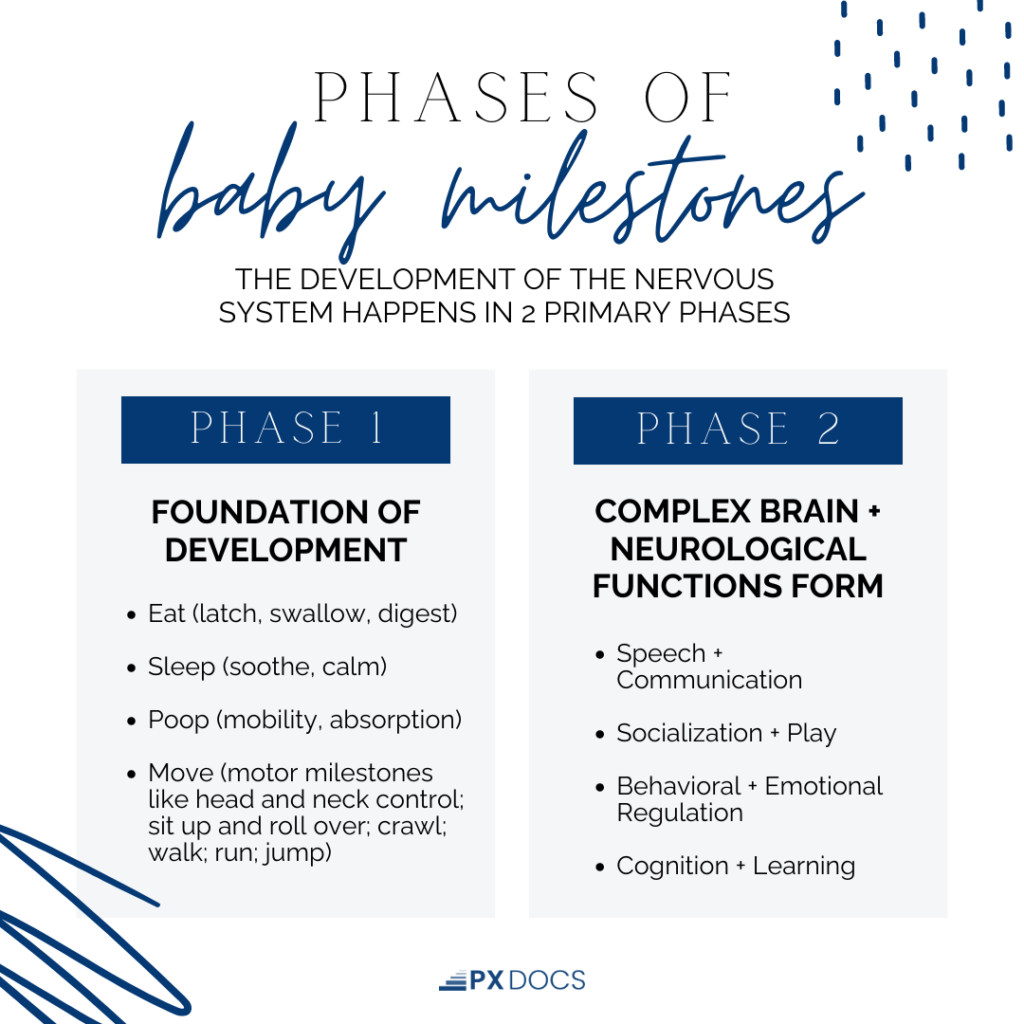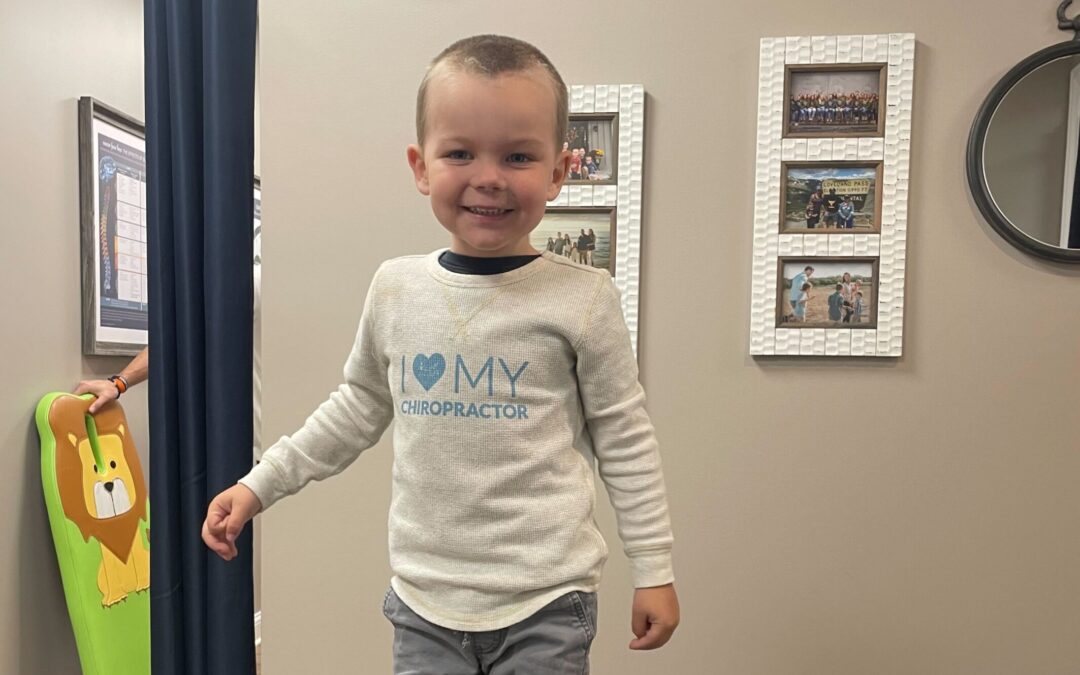Shortly after Isla was born, it became apparent that she had a side preference, always turning her head to the left while also struggling with movement. She had trouble lifting her chin from her chest and experienced challenges with eating as a newborn. This resulted in a flat spot on one side of her head.
Isla’s parents were determined to seek help for her but felt overwhelmed by the numerous appointments and lack of clear guidance they received. At the age of 2 months, they took her to a physical therapist (PT) to address her Torticollis, who recommended a helmet. However, they soon realized that the physical therapy wasn’t effectively improving her range of motion and realized a helmet would only provide a temporary solution without addressing the underlying root causes affecting her movement.
After researching natural care remedy options for Torticollis and Plagiocephaly, Isla’s parents decided to give Neurologically-Focused Chiropractic a try.
What are Baby Milestones?
In the journey of your baby’s first year of life, you’ll witness astonishing growth and development. Throughout this transformative period, your little one will achieve significant milestones, known as baby milestones.
Baby milestones are the critical developmental achievements that most infants reach within specific age ranges. These milestones encompass physical, cognitive, and social skills, indicating that a baby is progressing as expected. In the traditional medical world, they serve as markers for tracking a child’s growth and identifying potential concerns at an early stage.
What’s important to remember is that no two babies are exactly alike, each will follow his or her unique path of development. Many babies do reach certain milestones at somewhat similar ages, but it’s entirely normal for a healthy baby to show variations in different areas.
What Matters Most for Baby Milestones?
The most important thing we can share with you in this article is something you will absolutely not hear or have explained to you in a traditional pediatrician’s office, and that is this – the order in which your child goes through these milestones matters far more than when they achieve them.
Meaning this, it’s more troublesome for a child to skip a stage of development or miss a milestone altogether than it is to be slightly delayed. For example, skipping crawling is more troublesome and problematic to their overall brain and neurological development than being a couple of months “late” in talking, walking, and so forth.
This is why it was so alarming and concerning when the CDC recently updated their Developmental Milestones charts and took crawling out altogether, and then pushed back some core speech milestones by another 6 months. Crawling is a very important gross motor skill that helps get the right and left sides of the brain connected and coordinated together, helping improve not only motor coordination and function later on in life but cognitive development and emotional regulation as well.
Once again, all milestones are meant to be a general guide and should be interpreted with caution, especially when coming from the CDC or standard pediatrician only. We encourage all parents who have any questions or concerns about their baby’s development and milestones to consult with a trained and experienced PX Doc, who are experts in neurological development and function. You can also find more information about Developmental Milestones from our PX perspective here.
Important Baby Milestones
During the first couple years of life, babies undergo remarkable transformations. While each child is unique and may develop at their own pace, understanding the typical milestones and their significance can provide parents with valuable insights into their child’s growth.
They can be a sign if things are getting off track with your child’s development, which can lead to children experiencing significant neurological and other developmental challenges later on in life.
Below is a brief list of milestones by month. For a more detailed list, check out this article.
2 Months:
- Latches and breastfeeds easily and comfortably (on both sides)
- Soothes and sleeps well
- Easily digests their food and poops regularly
- Tracks objects
- Smiles at the sound of your voice
- Opens and shuts hands
- Brings hands to mouth
4 Months:
- Holds their head and neck steady without support
- Babbles, coos
- Brings objects to their mouth
- Pushes down when legs are placed on a firm surface
6 Months:
- Rolls both ways
- Pushes up with straight arms when on their tummy
- Sits without or with little support
- Transfers objects from hand to hand
- Responds to sounds by making sound
- Squealing noises
- Enjoys looking at themselves in a mirror
9 Months:
- Rolls in every direction
- Crawls
- Bangs two things together
- Uses fingers to pick up food and other objects
- Plays Peek-a-boo
- Shows several different facial expressions (happy, sad, angry)
- The emergence of fear around strangers
1 Year:
- Gets to a sitting position on their own
- Crawls
- Pulls up to stand
- Walks holding onto furniture
- Stands momentarily without support
- May begin walking on their own
- Takes objects in and out of containers
- Responds to “no”
- Waves
- Says “mama” and/or “dada”
18 Months:
- Walks independently
- Says at least 15 words
- Can hold and use a play telephone, fork, spoon
- Scribbles
2 Years:
- Begins to run
- Kicks a ball
- Climbs up and down furniture unassisted
- Uses simple phrases
- Follows simple instructions
- Imitates behavior
- Begins to show defiant behavior
Simplifying Baby Milestones into Two Phases

As mentioned above, we are more concerned with the order in which these milestones and developmental stages happen and how well they are linked or coordinated together.
Looking at things on the calendar and by age helps us become aware of a potential challenge or developmental delay, but it does nothing to help us identify the root cause of that potential problem or develop an action plan to help get your baby back on track.
As Neurologically-Focused Pediatric Chiropractors, the entire focus of our clinical care is to find and address the root cause(s) head-on. In order to do just that, we’ve got to first assess and measure the function of the central and autonomic nervous system. This is the single most important measurement we can do for the overall health of infants and children of all ages, and it’s the one function that a standard pediatrician or medical provider is not equipped to provide.
To keep it simple, the development of the nervous system happens in two (2) primary phases. Phase 1 is the foundation of development for your precious newborn baby. Phase 1 includes:
- Eat (latch, swallow, digest)
- Sleep (soothe, calm)
- Poop (mobility, absorption)
- Move (motor milestones – head and neck control; sit up and roll over; crawl; walk; run; jump)
Phase 2 is considered the “finishings” and is the phase where the more advanced and complex brain and neurological functions come into play: Phase 2 consists of:
- Speech + Communication
- Socialization + Play
- Behavioral + Emotional Regulation
- Cognition + Learning
Before these more advanced brain and neurological functions that are essential for a child’s success in social and school situations can develop and function properly, the foundational basics must be fully developed and healthy. Therefore if your child still struggles with sleep, constipation, or immune health, they will likely continue to stay stuck and delayed in their social, speech, and cognitive development as well.
This is why so many parents report to us that despite doing months or even years of therapy later in life, their child has made little to no progress. We must address the foundation first, and that is yet another thing that sets our PX Docs Network and clinical protocols apart from not just the pediatrician, but PT, OT, and Speech Therapy as well.
What Causes Babies to Miss Milestones?
As a child grows, their development becomes a journey marked by rapid changes in the brain. Week by week, millions of brain cells and neurons flourish, leading to a remarkable 64% increase in your one-year-old infant’s brain size compared to birth.
With such significant transformations happening, it is helpful to keep an eye on important baby milestones – but it is not the end all, be all. As stated above, the most important component of optimal brain and neurological development in babies is not “when” they reach a milestone, as much as it is in “what order” or “sequence,” they do it.
It is more beneficial to closely monitor the following key signs in your baby, as they may indicate the need to consult a trained Neurologically-Focused Pediatric Chiropractor specializing in neurodevelopment.
- Frequent stiffening, arching, head, and neck cranking, excessive crying
- Difficulty standing and inability to sit or stand independently by 12 months
- Skipping crawling altogether or quickly moving from crawling to standing with a stiff and tense posture
- Persistent struggles with sleep, digestion, and immune function
- Excessive crying and distress, with reduced eye contact, smiling, interaction, babbling, and imitating sounds
The Significance of Birth Trauma and Baby Milestones
Our PX Docs network digs down to the root causes of why your baby may be missing milestones and struggling with their health. The number one factor that we see over and over again that contributes to missed baby milestones is birth trauma, which affects crucial brainstem and cerebellum regions and their wildly important role in developmental milestones.
Birth is traumatic for your baby for numerous reasons, including the baby’s position in utero, the duration of the birth process, or birth interventions (c-section, vacuum, forceps). These all cause high levels of physical tension on the delicate tissues of the brainstem and upper neck, which house the vagus nerve and are responsible for autonomic nervous system regulation and function, motor tone and coordination, immune and digestive function, and so much more.
The impact of these various physical stressors on a developing infant’s nerves and muscles in the head, neck, and upper torso is significant. This leads to subluxation, which is often the most underestimated and overlooked aspect when considering developmental delays and neurodevelopmental challenges in babies and children later on in life as well.
If your baby is displaying signs of colic, reflux, constipation, or is having difficulty sleeping or eating, these are all indications that there is subluxation affecting your baby’s nervous system.
When your baby’s nervous system is subluxated, and they are in a sympathetic dominant state (fight or flight), that stops and limits development and milestone progression. This neurological imbalance is known as its own condition called dysautonomia.
And as renowned Cellular Biologist and leading Epigenetic Researcher Dr. Bruce Lipton perfectly states, “You can’t be in growth and protection at the same time.” So if your baby is stuck in sympathetic fight or flight mode, they can’t also be in growth and development mode. Which by far is the dominant mode your baby is supposed to be in and stay in for quite a while!
How Can Chiropractic Care Help with Baby Milestones?
We understand the significance of your concerns as parents. You have an unparalleled connection with your child, observing them 24/7. If your pediatrician isn’t giving due attention to your “gut instinct” concerns about your infant’s development, our PX Docs network is ready to help.
Parents need and deserve a different approach and that starts with a different perspective. Your baby deserves to be checked for subluxation, dysautonomia, and developmental delays early and often, and not rely on a “watch and wait” approach.
The most frustrating phrases we hear from countless parents who bring their kids in for care years down the road are, “we wish we had known this before” and “they told us not to worry, they’ll grow out of it.” Unfortunately, that is simply not the case. Again and again, we see in a child’s case history that they did not “grow out of” their colic or sleep challenges but instead grew “into” things like chronic gut issues, autoimmune challenges, sensory processing disorder, ADHD, anxiety, autism, and more.
It all starts with finding out to what degree and where precisely within your baby’s nervous system their tension and subluxations lie. Our trained and ready PX Docs start with an in-depth case history and examination of your baby and also utilize incredible technology called INSiGHT Scans.
These scans take only minutes to use, are entirely safe and non-invasive, and help find exactly where those areas of altered tone and tension are. Baby milestones can involve so much, and the rapidly developing brain and nervous system are quite intricate systems.
Isla’s parents noticed a change in her movement after her very first adjustment. She fell asleep in her car seat on the way home and wasn’t leaning to her preferred left side. She was also able to lift her chin from her chest when she was taking her bottle. After 5 adjustments at her PX Doc office, it was decided she no longer needed a helmet! The adjustments had given her the range of motion she needed to round out her head as she grew.
She continues to progress with each adjustment and is able to move her head easily in both directions. She is meeting her baby milestones in the correct order, and her parents know that she would not be where she is today without Neuroligically-Focused Chiropractic Care.
By optimizing your baby’s nervous system function and supporting development, our Neuro-Tonal Chiropractic Adjustments can be instrumental in fostering a healthy and thriving baby who meets all his or her milestones in the right order.
If you’re a parent seeking to provide the best possible start for your child’s development, check out our PX Docs directory to find a PX Doc local to you. They will help you explore the benefits of Neurologically-Focused Chiropractic Care for your baby’s early development and unlock the potential of your little one’s growth. Babies are meant to be healthy, meet their milestones and grow up with a strong foundation to become resilient, healthy, and thriving!





